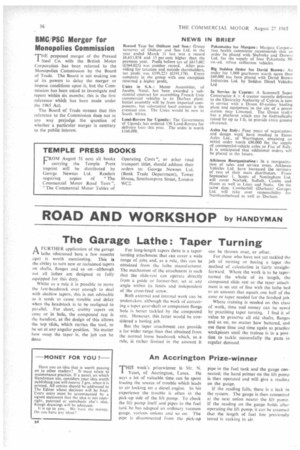ROAD AND WORKSHOP by HANDYMAN
Page 38

If you've noticed an error in this article please click here to report it so we can fix it.
The Garage Lathe: Taper Turning
AFURTHER application of the garage lathe (discussed here a few months ago) is worth mentioning. This is the ability to turn new or reclaimed tapers on shafts, flanges and so on—although not all lathes are designed or fully equipped for this duty.
Whilst as a rule it is possible to move the fast-headstock over enough to deal with shallow tapers, this is not advisable as it tends to cause trouble and delay when the headstock is to be realigned to parallel. For short, stubby tapers on cone or in hole, the compound rest is the handiest, as the design of this allows the top slide, which carries the tool, to he set at any angular position. No matter how steep the taper is, the job can he done.
For long-length tapers there is a taperturning attachment that can cover a wide range of jobs and, as a rule, this can be obtained from the lathe manufacturer. The mechanism of the attachment is such that the slide-rest can operate directly from a guide or former-bar, set at any angle within its limits and independent of the cross-feed screw.
Both external and internal work can be undertaken, although the work of correcting a taper gear-shaft or companion flange hole is better tackled by the compound rest. However, this latter would be considered a boring job.
But the taper attachment can provide a far wider range than that obtained from the normal loose headstock which, as a rule, is rather limited in the amount it can be thrown over, or Whet.
For those who have not yet tackled the job of turning or boring a taper the method of calculation is fairly straightforward, Where the work is to be taperturned the whole of its length, the compound slide rest or the taper attachment is set out of line with the lathe bed to an amount that equals one half of the cone or taper needed for the finished job.
Where training is needed on this class of work, time and money can be saved by practising taper turning. I find it of value to preserve all old shafts, flanges and so on, no matter how battered, and use these time and time again as practice workpieces until the trainee is in a position to tackle successfully the parts iu regular demand.












































































































